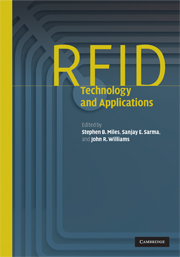Book contents
- Frontmatter
- Contents
- List of contributors
- Preface
- Acknowledgments
- 1 Introduction to RFID history and markets
- 2 RFID technology and its applications
- 3 RFID tag performance optimization: a chip perspective
- 4 Resolution and integration of HF and UHF
- 5 Integrating sensors and actuators into RFID tags
- 6 Performance evaluation of WiFi RFID localization technologies
- 7 Modeling supply chain network traffic
- 8 Deployment considerations for active RFID systems
- 9 RFID in the retail supply chain: issues and opportunities
- 10 Reducing barriers to ID system adoption in the aerospace industry: the aerospace ID technologies program
- 11 The cold chain
- 12 The application of RFID as anti-counterfeiting technique: issues and opportunities
- 13 Closing product information loops with product-embedded information devices: RFID technology and applications, models and metrics
- 14 Moving from RFID to autonomous cooperating logistic processes
- 15 Conclusions
- Appendix – links to RFID technology and applications resources
- Editor biographies
- Index
- References
7 - Modeling supply chain network traffic
Published online by Cambridge University Press: 02 November 2009
- Frontmatter
- Contents
- List of contributors
- Preface
- Acknowledgments
- 1 Introduction to RFID history and markets
- 2 RFID technology and its applications
- 3 RFID tag performance optimization: a chip perspective
- 4 Resolution and integration of HF and UHF
- 5 Integrating sensors and actuators into RFID tags
- 6 Performance evaluation of WiFi RFID localization technologies
- 7 Modeling supply chain network traffic
- 8 Deployment considerations for active RFID systems
- 9 RFID in the retail supply chain: issues and opportunities
- 10 Reducing barriers to ID system adoption in the aerospace industry: the aerospace ID technologies program
- 11 The cold chain
- 12 The application of RFID as anti-counterfeiting technique: issues and opportunities
- 13 Closing product information loops with product-embedded information devices: RFID technology and applications, models and metrics
- 14 Moving from RFID to autonomous cooperating logistic processes
- 15 Conclusions
- Appendix – links to RFID technology and applications resources
- Editor biographies
- Index
- References
Summary
Introduction and motivation
In the future, when the Internet of Things becomes reality, serialized data (typically RFID and/or barcode, based on EPCglobal, DOD/UID, and other standards) can potentially be stored in millions of data repositories worldwide. In fact, large data volumes of serialized information may be coming soon, as the global healthcare industry moves towards deploying anti-counterfeiting standards as soon as 2009. Such data will be sent to enterprise applications through the EPC network infrastructure. The data volume, message volume, communication, and applications with EPC network infrastructure will raise challenges to the scalability, security, extensibility, and communication of current IT infrastructure. Several architectures for EPC network infrastructure have been proposed. So far, most pilots have focused on the physical aspects of tag readings within a small network of companies. The lack of data quantifying the expected behavior of network message traffic within the future EPC network infrastructure is one of the obstacles inhibiting industry from moving to the next level. This chapter presents a simulator aimed at quantifying the message flows within various EPC network architectures in order to provide guidance for designing the architecture of a scalable and secure network.
RFID/EPC technology enables the tracking of physical objects through their lifecycles without direct human involvement. Through the wide range of initiatives, such as the one with retail giants (Wal-Mart and Target), and those with the Food and Drug Administration (FDA), numerous state boards of pharmacy, aerospace companies (Airbus and Boeing), and the Department of Defense (DoD), RFID/EPC/UID has demonstrated its great value for business operation automation.
- Type
- Chapter
- Information
- RFID Technology and Applications , pp. 87 - 100Publisher: Cambridge University PressPrint publication year: 2008
References
- 2
- Cited by

